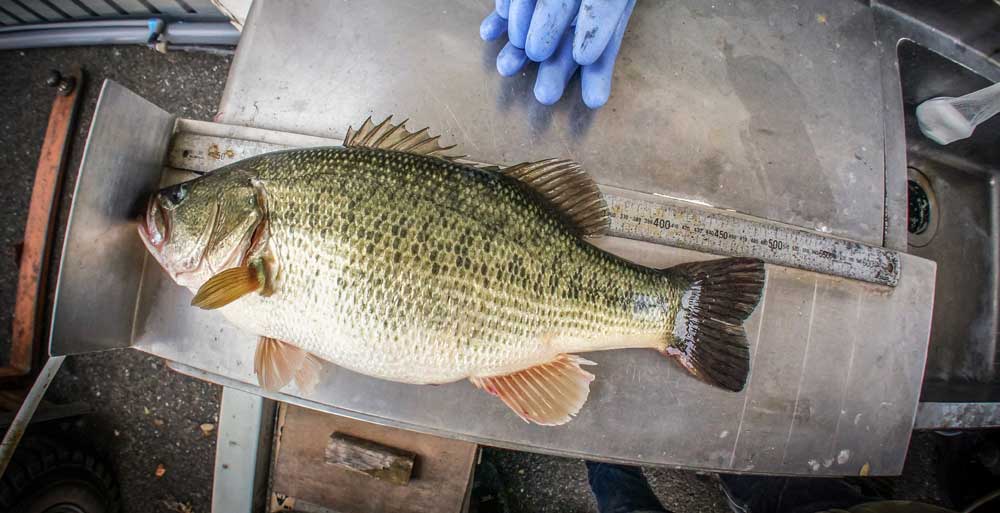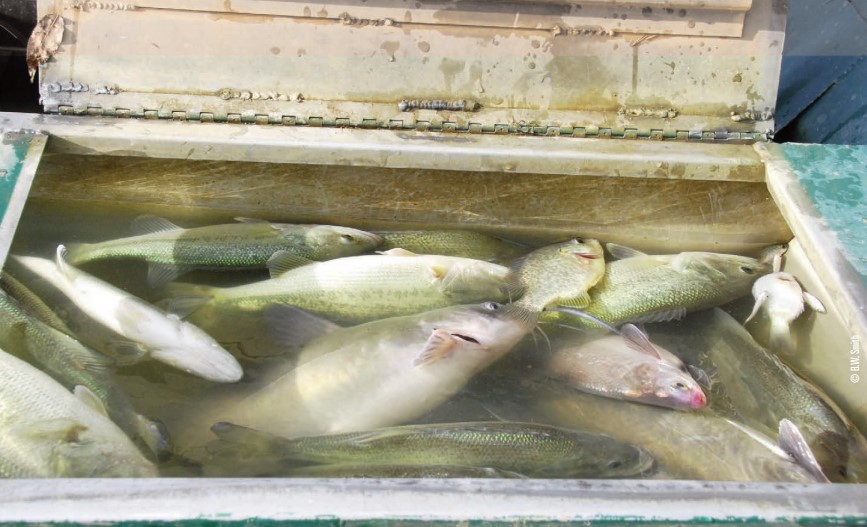Don C. Keller | Originally published in GameKeepers: Farming for Wildlife Magazine. To subscribe, click here.

Many landowners have preconceived ideas about what is going on with the fish population in their lakes. Fish culture is different from other forms of agriculture in that we cannot see what is going on in this underwater ecosystem. If we have five acres of pasture, we can count the cows or horses, we can look and see if they are skinny or fat, we can count the offspring, and we can tell how much food is available for future growth. In assessing a lake we are much more limited by visual observations since we cannot see below the surface.
The best way to determine the condition of your fish population is by electrofishing. This procedure gives fisheries biologists a powerful insight into the overall health of your lake.
A typical electrofishing boat transmits an electrical current from a generator through a sophisticated control box, called a Variable Voltage Pulsator, to a set of electrodes. The electrodes are a set of wires that are dangled in the water off of booms mounted at the front of the boat. When the operator of the boat presses a foot switch, an electrical field is formed around a relatively small area of the electrodes. Fish within this field are stunned and many float to the surface, where they can be collected with a long-handled dip net. The fish are placed in a livewell and later weighed and measured. This collection technique does not harm the fish. Almost all state and federal agencies obtain some of their hatchery broodfish by electrofishing.
After a representative sample of fish population has been collected, the fish in the livewell are tranquilized with a fish anesthetic. The fish are then measured for length and weighed to the nearest tenth of a pound. After these data are recorded, the fish are returned to the lake. A biologist, with the aid of a computer, conducts a series of scientific data analyses which gives us a much clearer picture of the fish population.
Relative weight (Wr) is a scientific measure of the current condition of your fish. It determines the plumpness of the fish and indicates if they are fat or skinny. The relative weight index is the ratio of the actual fish weight to a standard fish weight for a fish of the same length. For largemouth bass in the south, a Wr of 90 or more is desirable. If Wr is greater than 100, then the bass is fatter than a standard bass of the same length. This means the bass are growing fast, have plenty to eat and are in a trophy-bass condition. Bass that have a Wr of 80 or less are skinny, which means they are not getting enough food. This can be due to low fertility, competitive species, or lack of harvest. The Wr will often change with different size groups of bass. For instance, the Wr may be 80 for bass that are up to 16 inches but bass 20 inches and longer may be 100 or more. This means that the larger bass are eating large-size forage that the smaller bass can’t utilize.

Electrofishing also allows the biologist to establish a length frequency index. This is a way to estimate the numbers of fish in different size classes. For example, if 20 largemouth bass are collected and most were in the 10- to 14-inch size then we know that the lake is bass-crowded. Bass are not growing out of this size range because they do not have the right amount and size of forage available. This usually requires removing bass in this size range by angling and increasing the food supply by increased fertility, feeding, or adding supplemental forage, such as threadfin shad or more bluegill.
A length frequency index is usually established for both bass and bluegill. Large numbers of bluegill, particularly in the three- to five-inch size range, means that there is a good food supply for the bass.

Electrofishing allows the biologist to also make observations such as total species composition. If a competitive species such as crappie are found that the landowner did not stock, then strategies can be developed to address this situation. One solution to this problem is the addition of another forage fish.
This past winter was the coldest recorded in the southeast in more than 30 years. The extended cold spell caused some lakes to ice over for several days resulting in a winterkill of threadfin shad. By electrofishing, biologists were able to determine which lakes lost their shad, and hatcheries were able to restock threadfin shad in order to keep the bass growing at a healthy rate.
Electrofishing is an excellent tool that is necessary for good long-term fisheries management. Electrofishing lake surveys provide insight into the current state of your fish population and provide baseline data that allow biologists to monitor even small changes in the fish population. It provides the biologist with critical data needed to make recommendations to achieve the goals you have established for your lake. If you have questions about how your lake is progressing, or if your fishing is not what you want it to be, have your lake electrofished by a professional fisheries biologist.































